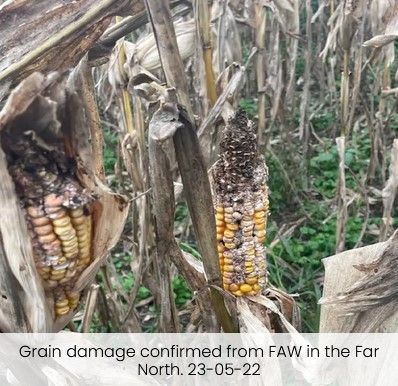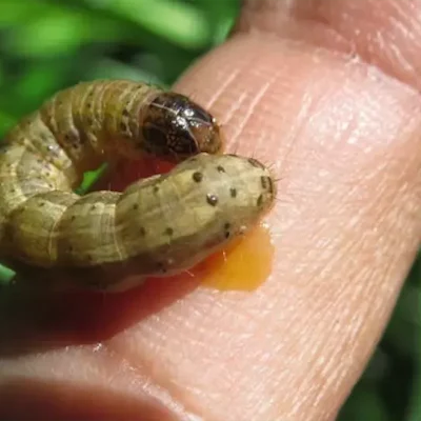- A very destructive pest
- Can fly 100kms in a night
- Affects crop at all growth stages
- Up to 12 overlapping generations per year
- Larvae feed on leaves, stems, flowers and grain
- Feeds on more than 350 other plant types
- Maize crop damage can be 50%! Or more.
IDENTIFY
Adults:
Dark gray, mottled forewings with light and dark splotches, and a noticeable white spot near the extreme end of each. About 38mm long.
Eggs:
Eggs are generally laid on the underside of leaves. Egg masses are grey or whitish in color with a hairy covering.
Larvae:
Newly hatched larvae are green in color and smooth-skinned.
Larvae can vary in color from light tan or green to nearly black as they develop. Larvae are similar in appearance to other caterpillars of related species and the head capsule markings are used to differentiate from other larvae. FAW larvae have a predominant white, inverted Y-shaped suture between the eyes and four raised spots on the second to last body segment.
Pupae:
Reddish-brown, 14-18 mm long. Pupation occurs within the soil.
MONITOR
Key Industries is working with MPI, F.A.R, and Maize Industry leaders to better understand FAW. For this purpose Key Industries are now importing Pheromone Monitoring Lures SPECIFIC to Fall Army Worm from our international partner Trécé, who are leaders in this technology.
Placement Time:
Late Spring
When crops are susceptible to damage.
Placement Pattern:
Edges of field or 16 to 24 rows from edge of field.
On windward side of field so pheromone will be blown into field.
Place traps at least 20 – 40m apart and 1.5m above the ground.
Trap Density:
Minimum of 2 per field
One trap per ha >8ha
Trap Maintenance:
Check twice weekly.
Change lures monthly.
Change liners monthly, or when dirty.


